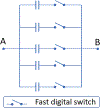Rapid scan EPR: Automated digital resonator control for low-latency data acquisition
- PMID: 36356489
- PMCID: PMC10266206
- DOI: 10.1016/j.jmr.2022.107308
Rapid scan EPR: Automated digital resonator control for low-latency data acquisition
Abstract
Automation has become an essential component of modern scientific instruments which often capture large amounts of complex dynamic data. Algorithms are developed to read multiple sensors in parallel with data acquisition and to adjust instrumental parameters on the fly. Decisions are made on a time scale unattainable to the human operator. In addition to speed, automation reduces human error, improves the reproducibility of experiments, and improves the reliability of acquired data. An automatic digital control (ADiC) was developed to reliably sustain critical coupling of a resonator over a wide range of time-varying loading conditions. The ADiC uses the computational power of a microcontroller that directly communicates with all system components independent of a personal computer (PC). The PC initiates resonator tuning and coupling by sending a command to MC via serial port. After receiving the command, ADiC establishes critical coupling conditions within approximately 5 ms. A printed circuit board resonator was designed to permit digital control. The performance of the resonator together with the ADiC was evaluated by varying the resonator loading from empty to heavily loaded. For the loading, samples containing aqueous sodium chloride that strongly absorb electromagnetic waves were used. A previously reported rapid scan (RS) electron paramagnetic resonance (EPR) imaging instrument was upgraded by the incorporation of ADiC. RS spectra and an in vivo image of oxygen in a mouse tumor model have been acquired using the upgraded system. ADiC robustly sustained critical coupling of the resonator to the transmission line during these measurements. The design implemented in this study can be used in slow-scan and pulsed EPR with modifications.
Keywords: Automated tuning and coupling; EPR imaging; Magnetic resonance; Rapid Scan EPR.
Copyright © 2022 Elsevier Inc. All rights reserved.
Conflict of interest statement
Declaration of Competing Interest The authors declare that they have no known competing financial interests or personal relationships that could have appeared to influence the work reported in this paper.
Figures







Similar articles
-
Modular imaging system: Rapid scan EPR at 800 MHz.J Magn Reson. 2019 Aug;305:94-103. doi: 10.1016/j.jmr.2019.06.003. Epub 2019 Jun 8. J Magn Reson. 2019. PMID: 31238278 Free PMC article.
-
Development of an L-band resonator optimized for fast scan EPR imaging of the mouse head.Magn Reson Med. 2021 Oct;86(4):2316-2327. doi: 10.1002/mrm.28821. Epub 2021 May 3. Magn Reson Med. 2021. PMID: 33938574 Free PMC article.
-
Development of an L-band rapid scan EPR digital console.J Magn Reson. 2019 Jul;304:42-52. doi: 10.1016/j.jmr.2019.05.003. Epub 2019 May 10. J Magn Reson. 2019. PMID: 31100585 Free PMC article.
-
Resonators for Clinical Electron Paramagnetic Resonance (EPR).2020 Aug 9. In: Berliner LJ, Parinandi NL, editors. Measuring Oxidants and Oxidative Stress in Biological Systems [Internet]. Cham (CH): Springer; 2020. Chapter 10. 2020 Aug 9. In: Berliner LJ, Parinandi NL, editors. Measuring Oxidants and Oxidative Stress in Biological Systems [Internet]. Cham (CH): Springer; 2020. Chapter 10. PMID: 33411447 Free Books & Documents. Review.
-
Measurement of oxygen concentrations in the intact beating heart using electron paramagnetic resonance spectroscopy: a technique for measuring oxygen concentrations in situ.J Bioenerg Biomembr. 1991 Dec;23(6):855-71. doi: 10.1007/BF00786005. J Bioenerg Biomembr. 1991. PMID: 1663949 Review.
Cited by
-
Dose-Specific Intratumoral GM-CSF Modulates Breast Tumor Oxygenation and Antitumor Immunity.J Immunol. 2023 Nov 15;211(10):1589-1604. doi: 10.4049/jimmunol.2300326. J Immunol. 2023. PMID: 37756529 Free PMC article.
-
Electron Spin Resonance Probe Incorporation into Bioinks Permits Longitudinal Oxygen Imaging of Bioprinted Constructs.Mol Imaging Biol. 2024 Jun;26(3):511-524. doi: 10.1007/s11307-023-01871-0. Epub 2023 Dec 1. Mol Imaging Biol. 2024. PMID: 38038860 Free PMC article.
References
-
- Tseytlin M, Continuouswave Rapid Scan EPR, in: Bode EB, V Chechik., D.M M (Eds.) Electron Paramagnetic Resonance, Royal Society of Chemistry, 2021. (publishing in progess).
Publication types
MeSH terms
Grants and funding
LinkOut - more resources
Full Text Sources

